THE DE LAUNE CYCLING CLUB ROLL OF HONOUR
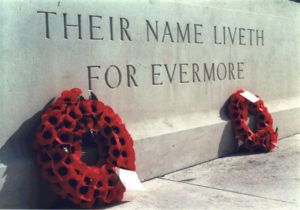
1914 - 1918
|
Introduction
I was asked by Mr Brian Saxton to
compile, from the names on the De Laune Cycling Club's War Memorial, a
book of remembrance dedicated to those Service Men of the Club who were
killed in the two World Wars. Information has been sought from War
Office and Air Ministry records, Battalion Histories, The Office Of
Births, Deaths and Marriages and not least from the "Budgets".
I have included many of the reports, particularly on the aircrew, as
they were written the following day.
It has not been possible, in some
cases, to identify exactly what happened to individuals, so I have had
to content myself with overall Battalion/Squadron actions on the day in
question. But overall I feel that the information contained in the
following pages gives an insight into the operations and actions that
involved these courageous men.
Mark Smith
OMRS WFA
September 1993 |
Rifleman F. C. REED
| Name: Frank Charles REED
Born: Mitcham
Lived: Mitcham
Enlisted: Westminster
Regiment: 16th (County of London) Battalion
(Queens Westminster Rifles)
Service No: 2475
Rank: Rifleman
Killed in Action: 17 June 1915 |
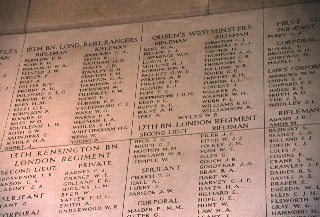
Commemorated: Menin Gate
Memorial to the Missing of the Ypres Salient, Ypres, Belgium - Panel 54
(13 down) |
| On the 17th June 1915, the 16th
Battalion Queens Westminster Rifles stretcher bearers and volunteers
from D Company, then in reserve, were employed all day in collecting and
clearing casualties from the battlefield; and during the night, the
operations having been completed, the Battalion returned to the canal
north of Ypres as Brigade reserve.
The 16th Battalion were holding a Trench line
between Potije and Hell Fire Corner (The Menin Road). Frank evidently
volunteered to go out into no-mans-land and collect the wounded from the
previous day's attack to secure some German trenches. He was killed by
an air burst shrapnel shell at about 4pm in the afternoon. Frank was
buried by his compatriots near to where he fell. Unfortunately his grave
was one of those that could not be located after the War, and his name
was inscribed on the Menin Gate Memorial. This Memorial was built on the
sight of a Medieval gateway to the town of Ypres and for four years was
known by all the servicemen, for, at some time or another, all had
passed through the Menin gate and up the Menin road to the trenches of
the Ypres salient. The memorial itself bears the names of 54,000 British
service men who were killed in the Salient and have no known grave.
NB Rfn. Reed's Service number and that of Rfn.
Tibbles indicate that they, and other members of the club or pals of
theirs, all joined together as the service numbers follow on in
numerical sequence. |
Rifleman P. J. TIBBELS
| Percival John TIBBELS
Born: Kensington 1890
Lived: Kensington
Enlisted: Westminster
Regiment: 16th (County of London) Battalion
(Queens Westminster Rifles)
Service No.: 2478
Rank: Rifleman
Son of: John and Florence Tibbles of Kennington
London
Killed in Action: 22 October 1915 Age 25 |
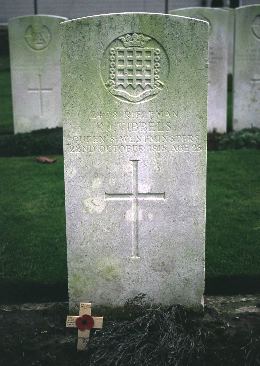 |
|
Buried: Potijze War
Cemetery - Row W Grave 22 |
| On the 17th October, the Battalion went into
dugouts on the canal bank, north of Ypres, leaving one Company forward
in the Potijze defences; and on the 20th, it relieved the West Yorkshire
Regiment in the trenches near Wieltje.
The only event of any importance on this tour was
a useful piece of patrolling and a clash with a German Working party on
the night of the 22 October, 1915.
It is known that Rfn. Tibbles was killed as a
result of a shell exploding on the parapet of the trench, the fragments
of which fatally wounded him. |
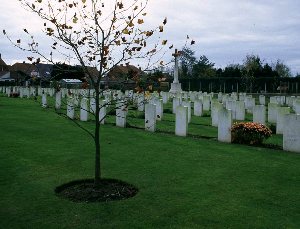 |
2nd Lieutenant W. H. WEBSTER DSO
| Name: Walter Henry WEBSTER
Born: 27th August 1895 in Islington, Middlesex
Lived: Simpson, Milton Keynes
Enlisted: London
Regiment: 4th Battalion The London Regiment
Rank: 2nd Lieutenant
Decorations: The Distinguished Service Order
London Gazette: 12 March 1917 Page 2476
Died of Wounds: 10 February 1917 aged 22 |
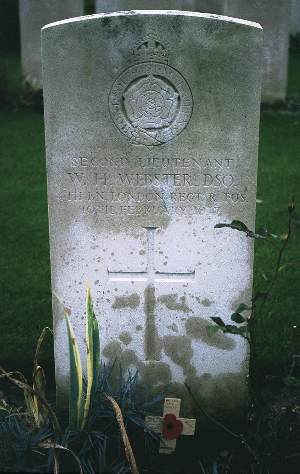 |
|
Buried: Rue-Petillon
Military Cemetery, 3 Miles from the village of Fleurbaix - Plot 1 Row J
Grave 14 |
| Extract The London Gazette 12 March 1917
The King is graciously pleased to confer upon 2nd
Lt. W.H. Webster the Distinguished Service Order for conspicuous
gallantry and devotion to duty. At great personal risk he picked up an
unexploded enemy projectile, and threw it over the parapet, where it
immediately exploded. He undoubtedly saved many lives. |
 |
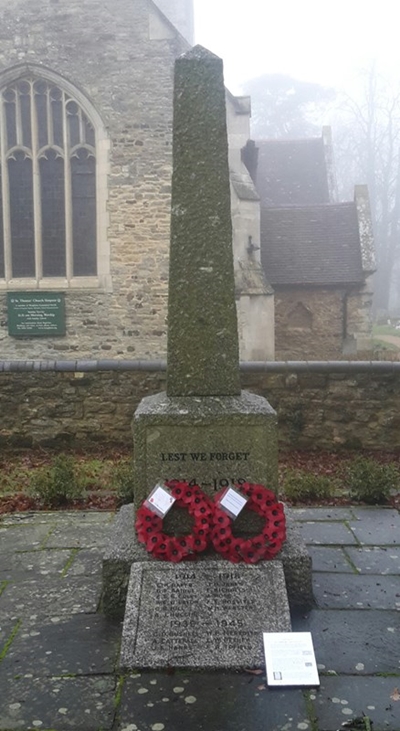 Four Extracts From The Battalion
History Four Extracts From The Battalion
History
29 June 1916 - The Somme
During the evening patrols had again been
despatched to investigate the enemy's wire and trenches, and this night
greater success was achieved. The right patrol which approached the
Boche line in front of Farm Farmyard under 2/Lt. W.H. Webster, who on
looking over the enemy's parapet found he had selected a firebay
containing a party of Boche hard at work. Unfortunately the alarm was
given and the presence of the patrol being disclosed by Very lights it
was forced to withdraw.
NB The 1st July 1916, two days latter, saw the
start of the Somme Offensive when, on the first day, 60,000 British
Soldiers were killed and wounded. 2/Lt. Webster took part in this great
attack and was one of the extremely lucky few to come through unscathed!
30 November 1916 - Neuve Chappelle - Fanqusart
In the Line, the Battalion was busily occupied
with its share of the work programme and in patrolling in which the
infrequency of encounters with the enemy in No Man's Land gradually led
to the belief that his (German} front breastwork was not occupied. This
was probed further on the last evening of November when a fighting party
of twenty men under 2/Lt. W.H. Webster (Intelligence Officer) entered
the enemy lines at the Wick Salient and found it untenable, in a
shocking condition of flood and apparently ample evidence that no
attempt was being made to repair the serious damage caused by our
artillery fire.
Lavente - December 1916
An act of gallantry occurred during the first tour
of the trenches in this area that must be recorded. During one of the
enemy's midday bombardments a time-fused medium trench mortar shell fell
on the parapet of our breastwork on the lip of the Mauquissart crater,
and lodged in the revetting hurdle at the side of the trench. The
firebay happened to be crowded with men working on the defences, and
heavy casualties must inevitably have been caused but for the bravery of
2/Lt. W.H. Webster, who rushed forward, seizing the shell, flinging it
over the parapet into the crater where it immediately exploded. For this
gallant act 2/Lt. Webster was awarded the DS0.
The La Bassee Road - "Pioneer Point" - 9
February 1917
At about 7pm, the enemy opened a heavy trench
mortar and machine-gun bombardment on the front line from Pioneer Point
to Pope's Point, astride the La Bassee Road. The trench mortar fire was
well directed, and the breastwork to the right of Pope Point was badly
breached. At about 7.3Opm this prepatory shelling was followed by a
heavy "box" barrage, and an enemy raiding party entered our
lines between Pioneer & Pope Point. A SOS signal was sent up from
the left company HQ, and our artillery responded promptly with a heavy
barrage on the German front line and communication trenches.
The raiders, about twelve in number, divided into
two groups, of which one attacked Pope Post and the other Pioneer Point.
The attack on Pope Post was driven off by the garrison, three of the
raiding party being bayoneted by Sgt. Gardiner, whereupon the others
turned and fled.
The raiders were successful in capturing 2/Lt. W.H.
Webster DSO, who was with the Lewis Gun team in Pioneer Post. He was
believed to have been mortally hit prior to his capture and died in
enemy hands the following day.
 |
Private William ENGLAND
| Name: William ENGLAND
Born: Lambeth Surrey 1881
Lived: Brixton Surrey
Enlisted: Lambeth
Regiment: 7th Battalion The Queens
Service No.: G/24603 formerly 10764 Royal Sussex
Regt.
Rank: Private
Killed in Action: 16 March 1918 Age 36 |
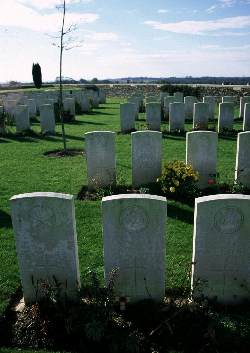 |
|
Buried: The Grand-Seraucourt
British Cemetery France Plot 6 Row I Grave 11 |
| The 7th Battalion The Queens Regiment were in the
vicinity of Varennes on the 16 March 1918. The Battalion history does
not make any mention of the actual day and so we must assume it was just
another day in the trenches on a tour of duty. Private England was
taking the opportunity, after the morning stand to, to have a shave at
his dug-out door when a high explosive shell fell near him, killing him
and several others near by, instantly. |
 |
Lance Corporal A. WILLIAMS
| Name: Arthur WILLIAMS
Born: Lambeth Surrey 1884
Lived: Walworth Surrey
Enlisted: LondonRegiment: 1st Battalion The Buffs
(East Kent Regiment)
Service No: G/13747
Rank: Lance Corporal
Son of: Thomas and Pricila Williams of Balham
London
Died Of Wounds: 22 March 1918 Age 33 |
 |
|
Buried: Dernancourt
Communal Cemetery Extension Plot 3 Row J Grave 26 |
| L/Cpl Williams was in the act of
showing an officer to a forward HQ position when he was hit by a machine
gun bullet in the stomach which came out through his thigh. He was taken
to a First Aid Station but unfortunately succumbed to these wounds the
following day. |
| The Battalion itself was in the vicinity of
Lagnicourt and Noreuil, when on the morning of the 21 March 1918 the
Germans launched their last great effort to win the war, the
Kaiserschlacht or King's Battle. The Kaiser himself was on the battle
field and his newly formed "storm troopers" attacked in
swirling mist at 9.4Oam. So swift was their advance with their new style
of warfare that by the end of the day they had captured more ground than
the British had in 4 months of fighting on the Somme in 1916. A last
ditch stand was made by the British Army and slowly as the momentum of
the Germans ran out the British began the final push that was to end the
Great War in November 1918. |
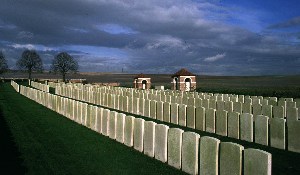 |
The Club President, John
Kavanagh, along with Brian Saxton, Titch Shambrook and Gordon Gibbens spent the
weekend of 10/11 November 2000 taking these photographs.

|
|